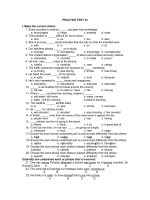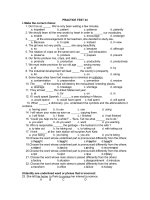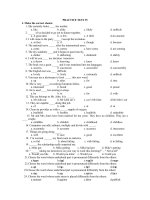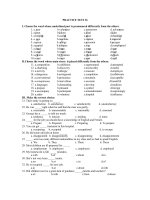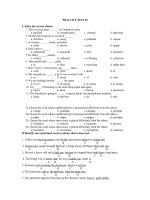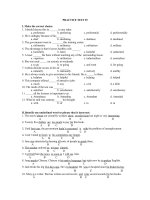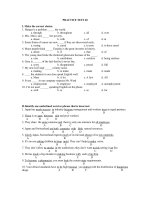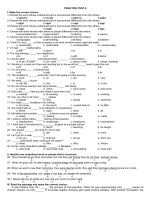đề kiểm tra tiếng anh lớp 12
Bạn đang xem bản rút gọn của tài liệu. Xem và tải ngay bản đầy đủ của tài liệu tại đây (5.38 MB, 20 trang )
ĐỀ THI HỌC KỲ I - ĐỀ SỐ 2
Môn: Tiếng Anh 12
Thời gian làm bài: 60 phút
Mark the letter A, B, C, or D to indicate the word whose underlined part differs from the other three in
pronunciation in each of the following questions.
Question 1: A. naked B. looked
Question 2: A. attempts
C. laughed
D. developed
B. shares
C. looks
D. beliefs
Mark the letter A, B, C, or D to indicate the word that differs from the other three in the position of the
primary stress in each of the following questions.
Question 3: A. typical
B. favorite
Question 4: A. certificate
C. division
B. necessary
D. organize
C. economy
D. geography
Mark the letter A, B, C, or D to indicate the word(s) CLOSEST in meaning to the underlined word(s).
Question 5: What may happen if John doesn’t arrive on time?
A. go along
B. count on
C. keep away D. turn up
Question 6: Tennis wear has become a very lucrative business for both manufacturers and tennis stars.
A. illegal
B. profitable C. circumstantial
D. expensive
Mark the letter A, B, C, or D to indicate the word(s) OPPOSITE in meaning to the underlined word(s).
Question 7: No one knew precisely what would happen to human being in space.
A. casually
B. flexiblely
C. wrongly
D. exactly
Question 8: All the students got high marks in the test but Mary stood out.
A. got very good marks
B. got higher marks than someone
C. got the most marks of all
D. got the fewest marks of all
Mark the letter A, B, C, or D to indicate the underlined part that needs correction in each of the following
questions.
Question 9: The major goals of primary education is to achieve basic literacy and numeracy among all students.
A. The major goal
B. is
C. to achieve D. and
Question 10: The colonist who first settled in New England did so because they felt there was none social
justice in their homeland of England.
A. who
B. did so
C. because
D. none
Question 11: Having been finished her household chores, Mary decided to do some shopping.
A. Having been finished
B. chores
C. to do
D. shopping
Mark the letter A, B, C, or D to indicate the correct answer in each of the following questions.
Question 12: They______ enthusiastically when their teacher ______ in.
A. discuss/ comes
B. will have discussed/ comes
C. will discuss/ came
D. were discussing/ came
Question 13: It is parents’ duty and responsibility to ______ hands to take care of their children and give them a
happy home.
A. shake
B. hold
C. join
D. take
Question 14: The world's biodiversity is declining at an unprecedented rate, which makes wildlife _______.
A. prosperous
B. prefect
C. vulnerable
D. remained Question 15: She is
______ I expected.
A. more prettier than
B. far prettier than
C. much more prettier than D. a lot prettier Question
16: ______ fuel that is used today is a chemical form of solar system.
A. Most of
B. The most
C. Most
D. Almost the
Question 17: Most foreign students don’t like American coffee, and ______
A. I don’t too B. neither did I
C. either don’t I
D. neither do I
Question 18: Nobody died in the accident, but 20 people were ______.
A. damaged
B. injured
C. spoiled
D. wounded
Question 19: If she ______sick, she would have gone out with me to the party.
A. hasn’t been B. wasn’t
C. weren’t
D. hadn’t been
Question 20: ______ he was lazy, he failed the exam.
A. So
B. Consequently
C. Thus
D. Now that Question 21:
Who was the first person ______ the South Pole?
A. to reach
B. who reaches C. reached
D. reaching Question 22:
There were ______ few tickets sold that the concert was cancelled.
A. a
B. very
C. so D. such
Question 23: Don’t worry. They will do the job as _____ as possible.
A. economically
B. economical
C. economic D. to be asked
Question 24: Peter: “How do you get to work?”
Mary: “__________________”
A. It is very far
B. I walk, of course
C. about 2 kilometres D. I was taken there
Question 25: John: “I don’t think I can do this.”
George: “ ___________________”
A. Oh, come on! Give it a try B. Yeah, it’s not easy
C. No, I hope not
D. Sure, no way!
Mark the letter A, B, C, or D on your answer sheet to indicate the sentence that is closest in meaning to each
of the following questions.
Question 26: It is not until a Vietnamese girl getting 18 years old that she is allowed to get married legally. A.
A Vietnamese girl is not allowed to get married legally only when she gets 18 years old.
B. A Vietnamese girl is allowed to get married legally only after she gets 18 years old.
C. They never allow a Vietnamese girl to get married legally when she is 18 years old.
D. The legal allowance for a Vietnamese girl to get married will be issued in 18 years.
Question 27: The thief wore gloves so as to avoid leaving any fingerprints. A.
The thief wore gloves so as to not leave any fingerprints.
B. The thief wore gloves so that not leave any fingerprints.
C. The thief wore gloves in order not to leave any fingerprints.
D. The thief wore gloves in order to not leave any fingerprints.
Question 28: He might have been joking when he said he was planning to leave home. A.
The idea of leaving home probably amused him a great deal.
B. I don’t know if he was serious when he expressed his intention of leaving home.
C. He could have made a joke about the situation when he left home.
D. He said he was going to leave home, but it turned out to be only a joke.
Mark the letter A, B, C, or D on your answer sheet to indicate the sentence that best combines each pair of
sentences in the following questions.
Question 29: My motorbike cannot start in the mornings. I think I will get the garage to repair it. A.
My motorbike cannot start in the mornings, so I will have it repaired.
B. My motorbike which I will have it repaired cannot start in the morning.
C. My motorbike which I will get it repaired cannot start in the mornings.
D. My motorbike I will get it repaired which cannot start in the mornings.
Question 30: Sue and Brian met. Shortly after that, he announced they were getting married. A.
As soon as Sue and Brian met, they announced they were getting married.
B. Right at the time Brian met Sue, he announced they were getting married.
C. Scarcely had Sue and Brian met when he announced they were getting married.
D. Until Sue and Brian met, they had announced they were getting married.
Read the following passage and mark the letter A, B, C, or D on your answer sheet to indicate the correct
word or phrase that best fits each of the numbered blanks from 31 to 35.
The General Certificate of Secondary Education or the GCSE examinations for _____(31) are the standard
school-leaver qualifications taken by_____(32) all UK students in the May and June following their 16 th
birthday. If you come to a UK _____ (33) school before you ______(34) the age of 16, you will study towards
GCSE examinations in up to 12 subjects. Some subjects are _____(35), including English and mathermatics,
and you can select others such as music, drama, geography and history from a series of options .
Question 31. A. short B. long
Question 32. A. similarly
C. big
D. a while
B. fortunately
C. approximately
Question 33. A. dependence B. independence
Question 34. A. reach
B. come
Question 35. A. necessary
B. compulsory
D. virtually
C. independent
C. approach
D. independently
D. go
C. optional
D. required
Read the following passage and mark the letter A, B, C or D on your answer sheet to indicate the correct
answer to each of the questions from 36 to 42
When most people hear the term “National Park”, they automatically think of names such as “Yellowstone”, or
“Yosemite”, or “Grand Canyon”. The big parks’ names bring to mind vast stretches of undisturbed wilderness
perfect for hiking, camping, and nature-watching. But while this vision of America’s National Parks is wholly
accurate and sufficiently breathtaking, there’s more.
America’s National Park system has an incredible 388 places to visit. This number includes not only the big
parks, but also monuments, historical sites, recreation areas, battlefields, as well as scenic lakeshores, and
rivers. And the Parks themselves don’t just stop at geyser-fields and mule-excursions. In America’s National
Parks, you can climb an active volcano in Hawaii, “spelunk” the vast underground world of Mammoth Cave in
Kentucky, dive the exotic coral reef of Biscayne Bay in Florida, or cast your fishing nets in the far reaches of
the Pacific with the locals of America Samoa. Each of these 388 places has a unique appeal – from the natural to
the manmade, from the ethereal to the factual, from the subtle to the overwhelming – with the whole collection
offering vacationers a nearly endless range of interests and activitists in which to explore and indulge.
SeeAmerica.org is a great place to begin planning your trip to one of, or several of, America’s National Parks.
From the home pages, you can search all of the Parks by name, region, activity, or even zip code. The site also
serves as a portal to other important sites, like the Nartional Park Sevice’s official website, www.nps.gove, and
the National Park Foundation’s www.nationalparks.org. From SeeAmerica.org, you can get to all the
information you will need to plan your trip from start to finish- from directions to the park, to park free, to
typical weather conditions.
Question 36: What is the most popular national parks in the USA?
A. Yellowstone
B. Yosemite
C. Grand Canyon
D. all are correct
Question 37: What is not true about the US national parks? A.
They are undisturbed wilderness.
B. In each natioal park, there are 388 places to visit.
C. They are perfect for camping.
D. Tourists to the parks can enjoy nature-watching.
Question 38: What is NOT included in the national parks?
A. monuments
B. seashores
C. zoos
D. big parks
Question 39: The word “breathtaking” mostly means_________?
A. extremely impressive
B. not bad
C. uninteresting
D. not shocking
Question 40: Which of these can be enjoyed in a national park in Hawaii?
A. Climbing an active volcano
B. Diving the exotic coral reef
C. Going fishing with the locals
D. Going on mule-excursions
Question 41: The word “indulge” mostly means _______?
A. wander off
B. enjoy yourself
C. live alone D. interfere with Question 42:
Which of the following statements is NOT true?
A. The names of parks just suggest part of the pleasure of visits to them.
B. There are 388 places of interest in the US national park system.
C. All you see at national parks are natural.
D. There are great variety of things for vacationers to enjoy.
Read the following passage and mark the letter A, B, C or D on your answer sheet to indicate the correct
answer to each of the questions from 43 to 50
In most discussions of cultural diversity, attention has focused on visible, explicit aspects of culture, such
language, dress, food, religion, music, and social rituals. Although they are important, these visible expressions
of culture, which are taught deliberately and learned consciously, are only the tip of the iceberg or culture.
Much of culture is taught and learned implicitly, or outside awareness. Thus, neither cultural insiders nor
cultural outsiders are aware that certain "invisible" aspects of their culture exist.
Invisible elements of culture are important to us. For example, how long we can be late before being impolite,
what topics we should avoid in a conversation, how we show interest or attention through listening behavior,
what we consider beautiful or ugly. These are all aspects of culture that we learn and use without being aware of
it. When we meet other people whose invisible cultural assumptions differ from those we have learned
implicitly, we usually do not recognize their behavior as cultural in origin.
Differences in invisible culture can cause problems in cross-cultural relations. Conflicts may arise when we are
unable to recognize others’ behavioral differences as cultural rather than personal. We tend to misinterpret other
people's behavior, blame them, or judge their intentions or competence without realizing that we are
experiencing cultural rather than individual differences.
Formal organizations and institutions, such as schools, hospitals, workplaces, governments, and the legal system
are collection sites for invisible cultural differences. If the differences were more visible, we might have less
misunderstanding. For example, if we met a man in a courthouse who was wearing exotic clothes, speaking a
language other than ours, and carrying food that looked strange, we would not assume that we understood his
thoughts and feelings or that he understood ours. Yet when such a man is dressed similarly to us, speaks our
language, and does not differ from us in other obvious ways, we may fail to recognize the invisible cultural
differences between us. As a result, mutual misunderstanding may arise.
Question 43: What is the main purpose of the passage?
A. To explain the importance of invisible aspects of culture.
B. To describe cultural diversity.
C. To point out that much of culture is learned consciously.
D. To explain why cross-cultural conflict occurs.
Question 44: The word “deliberately" in bold in paragraph 1 is closest in meaning to ___.
A. slowly
B. accurately
C. intentionally
D. randomly
Question 45: The phrase "the tip of the iceberg" in bold in paragraph 1 means that ____.
A. other cultures seem cold to us
B. visible aspects of culture are learned in institutions
C. we usually focus on the highest forms of culture
D. most aspects of culture cannot be seen
Question 46: It can be inferred paragraph 3 that conflict results when_______
A. people think cultural differences are personal
B. people compete with those from other cultures
C. one culture is more invisible than another culture
D. some people recognize more cultural differences than others
Question 47: According to the passage, which of the following is NOT true?
A. We are often aware that we are learning about culture
B. Visible aspects of cultures receive much attention in discussion of cultural diversity
C. People misinterpret other people's behavior because they know they are experiencing cultural differences
D. Invisible cultural differences are often witnessed at formal organizations and institutions Question 48: The
author implies that institutions such as school and workplaces _______.
A. are aware of cultural differences
B. teach their employees about cultural differences
C. reinforce invisible cultural differences
Kiế
Giả
9 Truy cập trang để học Toán – Lý – Hóa – Sinh – Văn –
Anh – Sử - Địa – GDCD tốt nhất!
Kiế
Giả
10 Truy cập trang để học Toán – Lý – Hóa – Sinh – Văn –
Anh – Sử - Địa – GDCD tốt nhất!
Kiế
Giả
11 Truy cập trang để học Toán – Lý – Hóa – Sinh – Văn –
Anh – Sử - Địa – GDCD tốt nhất!
Kiế
Giả
12 Truy cập trang để học Toán – Lý – Hóa – Sinh – Văn –
Anh – Sử - Địa – GDCD tốt nhất!
13 Truy cập trang để học Toán – Lý – Hóa – Sinh – Văn –
Anh – Sử - Địa – GDCD tốt nhất!
14 Truy cập trang để học Toán – Lý – Hóa – Sinh – Văn –
Anh – Sử - Địa – GDCD tốt nhất!
15 Truy cập trang để học Toán – Lý – Hóa – Sinh – Văn –
Anh – Sử - Địa – GDCD tốt nhất!
Đáp án: C
Dịch bài đọc:
Khi hầu hết mọi người nghe thuật ngữ "Vườn quốc gia", họ sẽ tự động nghĩ đến những cái
tên như
"Yellowstone", hoặc "Yosemite", hoặc "Grand Canyon". Tên của các công viên lớn gợi lên những vùng hoang
dã bao la rộng lớn, hoàn hảo cho việc đi bộ đường dài, cắm trại và ngắm thiên nhiên. Tuy nhiên, trong khi tầm
nhìn của các Công viên Quốc gia Hoa Kỳ hoàn toàn chính xác và kỳ vỹ, chúng ta còn có nhiều hơn thế. Hệ
thống Vườn Quốc gia Hoa Kỳ có 388 địa điểm tham quan. Con số này không chỉ bao gồm các công viên lớn,
mà còn cả các lăng mộ, di tích lịch sử, khu vui chơi giải trí, chiến trường, cũng như các cảnh đẹp hồ và sông. Và
các công viên tự nó không chỉ dừng lại ở đài phun nước và những chuyến dã ngoại. Tại các Công viên Quốc gia
của Hoa Kỳ, bạn có thể leo lên một ngọn núi lửa đang hoạt động ở Hawaii, "vuốt ve" thế giới ngầm dưới lòng
đất của Hang Mammoth ở Kentucky, lặn xuống các rặng san hô kỳ vỹ của vịnh Biscayne ở Florida, hoặc ném
lưới đánh cá xa bờ Thái Bình Dương với người dân địa phương của Mỹ vùng Samoa. Mỗi nơi trong số 388 địa
điểm này đều có sức hấp dẫn độc đáo - từ thiên nhiên cho tới nhân tạo, từ huyền ảo đến chân thực, từ tinh tế đến
kỳ vỹ - với toàn bộ chuỗi dịch vụ cung cấp cho du khách một phạm vi gần như vô tận các lợi ích và các nhà
hoạt động để khám phá và thưởng thức.
SeeAmerica.org là một nơi tuyệt vời để bắt đầu lên kế hoạch cho chuyến đi của bạn tới một trong số các Công
viên Quốc gia của Mỹ. Từ trang chủ, bạn có thể tìm kiếm tất cả các công viên theo tên, vùng, hoạt động, hoặc
thậm chí mã zip. Trang web này cũng là cổng thông tin cho các trang web quan trọng khác, như trang web chính
thức của Nartional Park Sevice, www.nps.gove, và www.nationalparks.org của Quỹ National Park Foundation.
Từ trang SeeAmerica.org, bạn có thể nhận được tất cả các thông tin bạn cần để lên kế hoạch cho chuyến đi của
bạn từ đầu đến cuối - từ lộ trình tới công viên, bãi đậu xe miễn phí, với điều kiện thời tiết điển hình.
Question 43
Tạm dịch: Mục đích chính của đoạn văn là gì?
A. Giải thích tầm quan trọng của các khía cạnh vô hình của văn hoá.
B. Mô tả tính đa dạng văn hoá.
C. Chỉ ra rằng phần lớn văn hoá được học một cách có ý thức.
D. Giải thích tại sao xung đột văn hoá xảy ra.
Thông tin: Thus, neither cultural insiders nor cultural outsiders are aware that certain "invisible" aspects of
their culture exist…. Invisible elements of culture are important to us…. Differences in invisible culture can
cause problems in cross-cultural relations.
Đáp án: A
19 Truy cập trang để học Toán – Lý – Hóa – Sinh – Văn – Anh – Sử - Địa
– GDCD tốt nhất!
Trong hầu hết các cuộc thảo luận về sự đa dạng văn hoá, sự chú ý tập trung vào những khía cạnh có thể nhìn
thấy được, rõ ràng của văn hoá như ngôn ngữ, trang phục, ẩm thực, tôn giáo, âm nhạc và các nghi thức xã hội.
Mặc dù chúng rất quan trọng, nhưng những biểu hiện văn hoá rõ ràng này, được dạy một cách có chủ ý và học
hỏi một cách có ý thức, chỉ là phần nổi của tảng băng trôi hoặc văn hoá. Phần lớn văn hoá được giảng dạy và
học hỏi ngầm, hoặc nhận thức bên ngoài. Do đó, không những người trong cuộc mà cả người ngoài cuộc biết
rằng những khía cạnh "vô hình" của văn hoá luôn tồn tại.
Các yếu tố vô hình của văn hoá là quan trọng đối với chúng ta. Chẳng hạn, chúng ta có thể đến trễ bao lâu trước
khi điều đó trở nên bất lịch sự, những chủ đề nào nên tránh trong cuộc trò chuyện, làm thế nào để thể hiện sự
quan tâm hay chú ý thông qua sự lắng nghe, điều nào đó là đẹp hay xấu. Đây là tất cả các khía cạnh của văn hoá
mà chúng ta học và sử dụng mà không nhận thức được nó. Khi chúng ta gặp những người có những giả định
văn hoá vô hình khác với những gì mà chúng ta đã ngầm học, chúng ta thường không nhận ra hành vi của họ
như là nguồn gốc văn hóa.
Sự khác biệt về văn hoá vô hình có thể gây ra những vấn đề trong quan hệ giao thoa văn hoá. Mâu thuẫn có thể
nảy sinh khi chúng ta không thể nhận ra sự khác biệt hành vi của người khác là liên quan về văn hóa chứ không
phải là xuất phát từ cá nhân. Chúng ta có khuynh hướng diễn giải sai về hành vi của người khác, đổ lỗi cho họ,
hoặc đánh giá ý định hoặc năng lực của họ mà không nhận ra rằng chúng ta đang gặp phải sự khác biệt về văn
hoá chứ không phải là sự khác biệt cá nhân.
Các tổ chức chính thức và các cơ sở giáo dục, chẳng hạn như trường học, bệnh viện, nơi làm việc, chính phủ và
hệ thống pháp luật là các địa điểm tập trung những sự khác biệt về văn hoá vô hình. Nếu sự khác biệt được nhìn
thấy rõ hơn, chúng ta có thể có ít hiểu nhầm hơn. Ví dụ, nếu chúng ta gặp một người đàn ông trong một tòa án
đang mặc quần áo lạ mắt, nói một thứ tiếng khác hẳn chúng tôi và mang theo những món ăn kỳ lạ, chúng tôi
không cho rằng chúng tôi hiểu ý nghĩ và cảm xúc của anh ta hay anh ta cũng hiểu suy nghĩ của chúng tôi. Tuy
nhiên, khi một người đàn ông ăn mặc tương tự như chúng tôi, nói ngôn ngữ của chúng tôi, và không khác với
chúng tôi ở những điểm rõ ràng, chúng tôi có thể không nhận ra sự khác biệt văn hóa vô hình giữa chúng tôi.
Kết quả là sự hiểu lầm lẫn nhau có thể nảy sinh.
22 Truy cập trang để học Toán – Lý – Hóa – Sinh – Văn – Anh – Sử - Địa
– GDCD tốt nhất!

